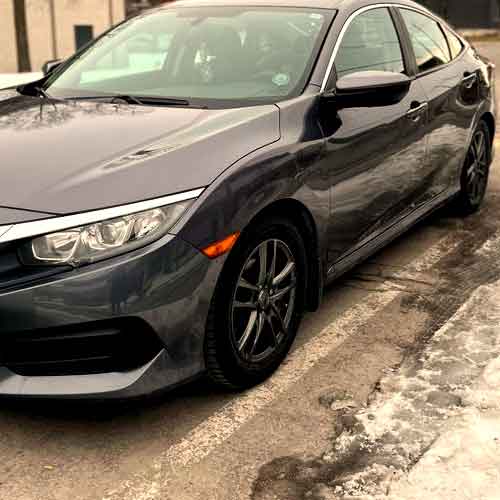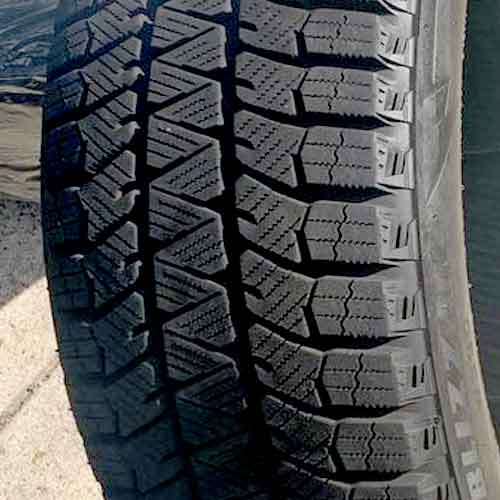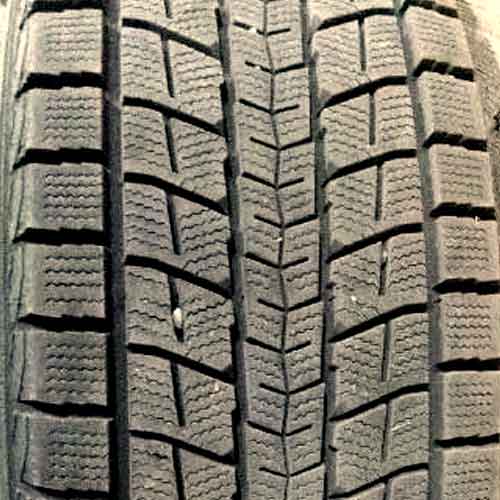In the fierce world of winter driving, the Dunlop Winter Maxx SJ8, with its formidable ice-gripping technology, takes on the Blizzak Ws90, known for its unmatched slush performance. Let’s see which tire comes on top.

Table of Contents
Tire Sizes
The Bridgestone Blizzak WS90 (review) comes in 52 total sizes in 15 to 19 inches (wheels) with following specs.
- Speed ratings: T or H.
- Load ratings: SL or XL.
- Tread depth: 11 or 12/32″.
- Weight: 17 to 29 lbs.
- Tread warranty: None.
On the other side, the Dunlop Winter Maxx SJ8 comes in 16 to 21 inches
- Speed ratings: R, S and T.
- Load ratings: SL and XL.
- Tread depth: 14/32″ on all.
- Weight: 21 to 40 lbs.
Tread Appearance
The Bridgestone Blizzak WS90 is a strong directional tire made for extreme snow traction. Let’s understand it a bit better.

When you look at the tire, you’ll see three parts, or ‘ribs’.
The one in the middle doesn’t have blocks, so its a continuous running one.
It features a lot of siping, along with lateral slits, which get wider towards the edges.
They then meet V-shaped notches, which help the tire grip the road.
The two other ribs carry the shoulder lugs.
These look like they’re split but aren’t, because the slits aren’t full depth, so they only act as in-groove notches.
These shoulder blocks also have side-facing biters, and of course, like all over the tread, you also get a lot of wave-like siping here as well.
On the other hand, Dunlop Winter Maxx SJ8 also features a directional pattern.

So dividing its tread in a similar way, we get to see 3 ribs, or you can say columns of blocks in the middle.
And these make 4 longitudinal channels.
The middle most rib is made continuous, meaning there aren’t any proper blocks formation there as the slits you see aren’t full depth.
So this rib is engraved with thick slits which look like a vine of leaves. These are basically considered as snow sipes, and with their angled orientation, they provide ample grip.
Though adding to that grip are numerous wave-like sipes and sharp off-set edges.
The surrounding ribs have blocks of bigger proportions. And they carry chamfered edges, off-set sides and in-groove notches along with those sipes.
Lastly shoulder lugs have zigzag edges, and they form widest of all longitudinal grooves in front of them.
Wet Grip
Both tires, here, have ample siping and flexible tread rubber, so you get amazing directional grip with them.
In fact upon testing, you get to see that both tires come up with similar braking distances (calculated on average). So you get a similar grip on both.
Though in terms of handling, you get slightly better results with the Blizzak WS90.
This is because the overall sipes on this tire has some more engineering advancements. Not only they are more aggressively interlocked with each other, they also have multiple angles to them, allowing for gripping in both lateral and longitudinal angles.
Conversely, the Dunlop Winter Maxx SJ8, which has laterally oriented sipes (for the most part), shows a deficiency in overall handling times during testing.
So overall, you can say, that Blizzak WS90 has the upper hand here.
Fuel Usage
Tire fuel efficiency is fundamentally connected to tread design and structural weight, as these elements dictate the rolling resistance, thereby directly affecting fuel consumption.
In this context, both the Blizzak and Dunlop demonstrate comparable efficiency, albeit for very distinct reasons.
Despite its lighter weight, the Blizzak WS90 utilizes a more thermally adaptive rubber that causes its lugs to flex more, thereby using more energy.
Conversely, the Dunlop Winter Maxx SJ8 counterbalances this effect. While its heavier weight imposes greater force on the lugs, it still manages to achieve similar fuel consumption levels to the WS90.
In essence, both tires exhibit approximately the same rolling resistance values, thus resulting in comparable miles per gallon.
Fluffy Snow Traction
On soft snowy terrains, the Dunlop Winter Maxx SJ8 manages to edge forward a little bit. And it achieves this through its extensive array of gaps or biters that function as snow traps.
If you consider the tread pattern of both tires, you’d note that the Dunlop carries more lateral and longitudinal grooves/in-groove notches, along with snow-vices on shoulder blocks (missing on its counterpart).
These snow traps promote a stronger snow-to-snow connection, which forms the tire’s contact patch with the ground, thereby increasing traction. But why?
Well, this effect is due to the fact, that snow adheres more effectively to itself, than it does to rubber.
In contrast, the Bridgestone Blizzak WS90 lacks these specific features. I mean don’t get me wrong, you still get a lot of biters here too, they are just a little behind in providing as much snow to snow contact as its competitor.
(With missing interconnected grooves on shoulder ribs, there’s aren’t just as many voids as you see on the other tire).
So the Dunlop SJ8 takes the lead here.
Dry Traction
Dry traction, an essential performance criterion for tires, hinges on the amount of rubber in contact with the road. And here two key factors dominate, directional grip, and lateral traction.
Let’s delve into each one.
Directional Grip
The effectiveness of directional grip primarily lies in the tread’s center, since it bears the majority of the tire’s load, especially during straight-line driving on highways.
This characteristic accounts for why the Dunlop Winter Maxx SJ8 excels in this domain.
While both tires feature continuous central ribs for consistent road contact, the Winter Maxx SJ8’s more contained pattern, extending to the surrounding lugs, contributes to an average braking distance reduction of 3 feet in comparison to the Blizzak WS90.
Hence, the Dunlop Winter Maxx SJ8 exhibits superior directional grip.
Handling
Handling quality primarily depends on the tire’s shoulder structure and overall weight. Let me explain, why that’s the case.
During cornering, inertia redistributes weight to the tread’s edges (shoulders/sidewalls), and although both tires offer almost similar footprints from there, the Dunlop still lacks more with its greater weight causing lugs to bend more.
This excessive flexing of the lugs then result in a reduced/limited balance between under and over steering, compromising on the tire’s overall steering feedback.
And so overall dry handling becomes better on Bridgestone Blizzak WS90.
Ice Traction
When evaluating performance on icy surfaces, the Bridgestone Blizzak WS90 is a relative standout.
The tire integrates advanced design features, like evenly dispersed specialized biters across the tread, fitted with V-shaped notches, simply allow for a better bite on packed up terrains.
And here the tire’s variety of siping angles, further add to that. As design choice supplies the tire with a comprehensive grip in all directions.
On the other hand, the Dunlop Winter Maxx SJ8 lacks in as aggressive of an overall siping pattern, with missing (multiple) angles. So overall ice traction becomes limited here.
Comfort Levels
Ride comfort fundamentally consists of noise reduction and the tire’s capacity to absorb shocks from the road.
Let’s address noise first.
Noise primarily originates when air particles collide with the walls of the tire’s tread. The more worn a tire becomes, the noisier it tends to be.
However, there’s more to consider, such as in-groove resonance, and that’s where the Dunlop Winter Maxx SJ8 excels, providing an overall quieter ride.
In-groove resonance essentially refers to the echoing effect within the tread walls, and of the two tires, the Bridgestone Blizzak WS90’s softer rubber compound reflects a greater amount of noise.
In contrast, the Dunlop Winter Maxx SJ8 not only produces less echo but also employs superior pitch sequencing technology. This technology utilizes varying tread block geometries to generate different sound tones from air particles. These tones eventually counteract each other, resulting in noise reduction.
Nevertheless, the Bridgestone Blizzak WS90, with its softer rubber compound, shines when it comes to shock absorption. Its rubber composition more effectively absorbs the vibrations caused by the road, making it comparatively better in this aspect.
Tread Life
Tread life is shaped by a mix of factors such as tire weight, tread depth, design, and compound composition. And upon analyzing these elements, it becomes apparent why the Dunlop Winter Maxx SJ8 holds the advantage.
Despite its heavier weight exerting more force on the lugs, the tire’s robust tread life can be attributed to its relatively harder rubber compound and deeper tread depth.
The harder compound resists rapid wear, and the greater tread depth means the tire lasts longer, as it takes more time to wear down to the legal tread depth limit of 2/32″.
Conversely, the Bridgestone Blizzak WS90, while having a more thermally adaptive rubber that significantly aids its performance on icy terrain, exhibits quicker wear.
Furthermore, its shallower tread depth does not contribute favorably to its overall tread life.
Summing Up
So what did we learn here?
Well that each tire shines in different areas.
When it comes to fuel efficiency, although both tires show up with similar performances, the overall tread life is still seen better on Dunlop.
On snow, the Dunlop edges ahead with more snow traps, enhancing traction. Its robust directional grip on dry surfaces also stands out.
Though it lacks to its counterpart in terms of handling in both wet and dry areas, and same goes for icy terrains.
And yes, Bridgestone Blizzak WS90 is also a better pick when it comes to impact comfort, though the Dunlop Winter Max SJ8 is a quieter pick.